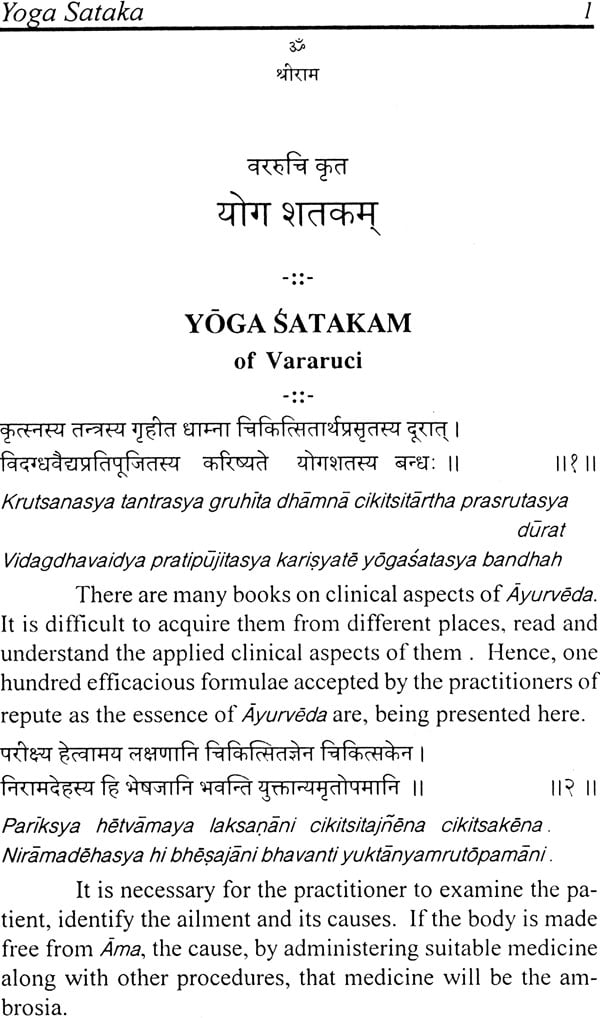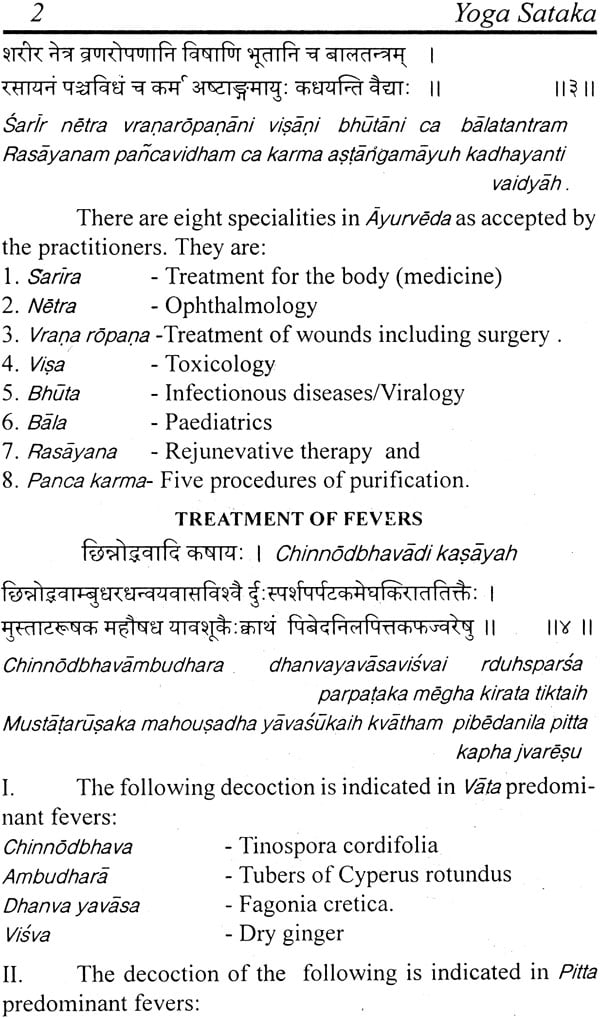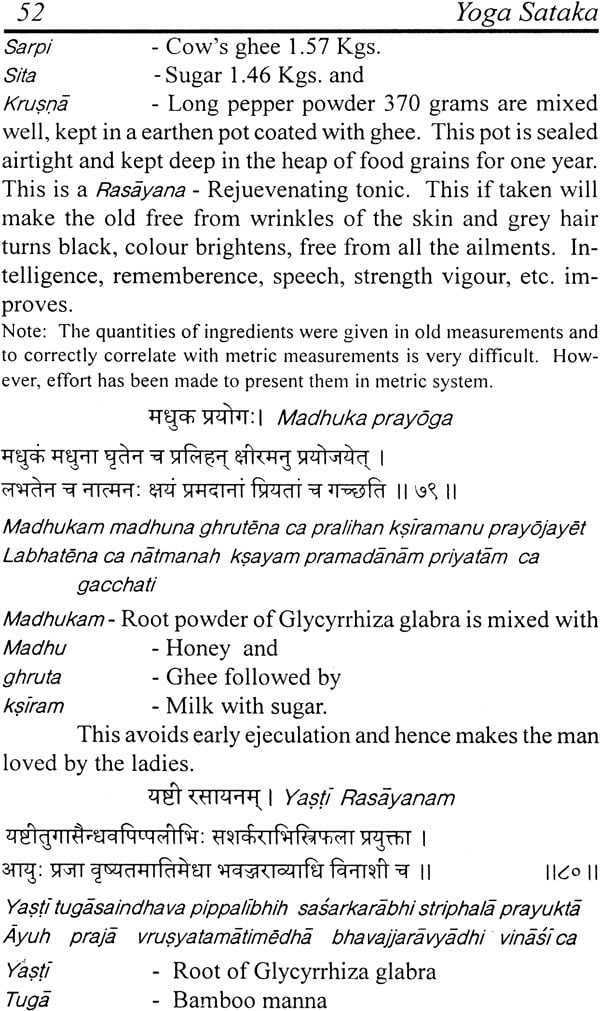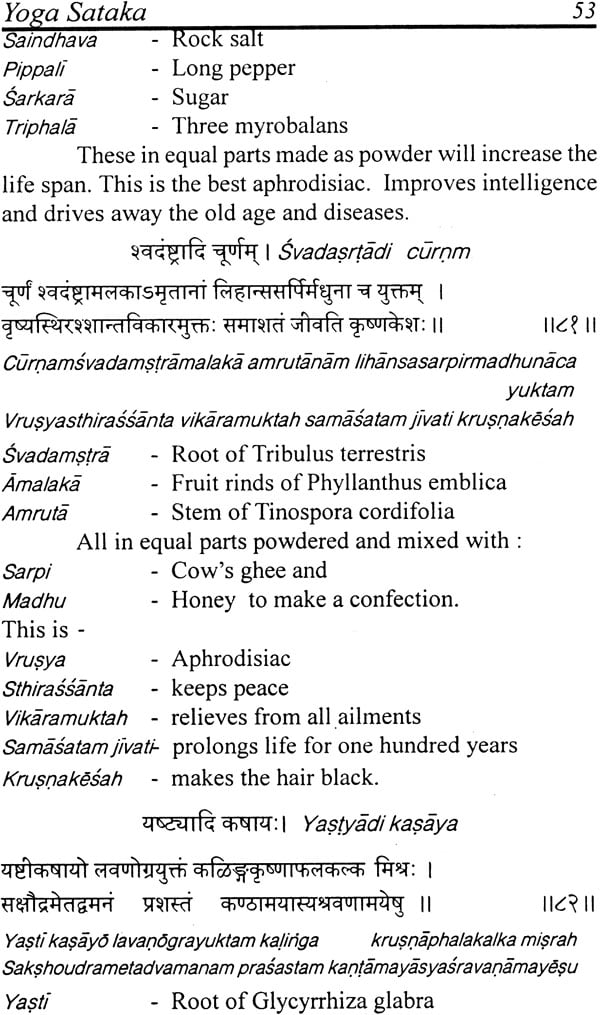
Yoga Satakam of Vararuci (A Hand Book for the Practitioners of Ayurveda)
Book Specification
| Item Code: | IDJ746 |
| Author: | Uttam Vaidya Pammi Satyanarayana Sastry |
| Publisher: | Chowkhamba Sanskrit Series Office |
| Language: | (Sanskrit Text with English Translation) |
| Edition: | 2007 |
| ISBN: | 9788170802396 |
| Pages: | 95 |
| Cover: | Paperback |
| Other Details | 8.2" X 5.2" |
| Weight | 110 gm |
Book Description
About the Book
This Yoga sataka was said to be Vararuchi. There may be many Vararuchi. One is familiarly known, as one of Navaratnas in the court of Vikramaditya. Another work Astakarmasthanam is also of Vararuchi. There are many mss, by name Yoga sataka viz. Vidagdha Vaidya, Sripandita, Amruta prabhava, Pumachandra. Yogasataka vyakhya by Samanthabhadra etc. A commentary in Sanskrit by Purnasena is also available.
Oriental Research Institute of Mysore published Yoga sataka of Panditaraya in 1985 under the editorship of Vaidya Sri C. Somayaji, DSAC, HPA and Sri H. Shankaraganapathi Phatak, M.A.. with the Sanskrit commentary of Purnasena. This was edited from seven mss. available to them. In introduction, it was said that the authorship is dificult to decide among Sripanditaraya, Sripandita, Nagarjuna and Vararuchi. Hence, the period of the author also is difficult to decide. It was also said that this book available in Sinhala and studied in Sri Lanka. It is noteworthy that two sanskrti commentaries are available and is translated into Sinhala.
The present translation is based on a Telugu translation of Vaidya Akondi Suryanarayana murti of Tatipati, in the East Godavari District of Andhara Pradesh published in 1951. The translator mentioned that that he took the assistance of a translation (probably in Hindi) of Pandita Jvala Prasad Misra. There are few mistakes in the Telugu translations also. They have been attended to the extent possible. I cold not obtain the translation of Pandita Jvala Prasad Misra.
The publication of ORI/Mysore has 247 slokas/Yogas/ subjects. This is felt that contradicts the very title Yoga Sataka. It is the practice that in every Sataka, one hundred or one hundred and sixteen stanzas are given. Where as in the above publication, there are 217. The reasons for increase in the number of stanzas can be attributed to -
1. This being a popular work, several Vaidyas would have added/ corrected the original stanzas based on their experience.
2. As the name implies, this work should have, only the Yogas and not dignosis part. But Mysore publication has it.
Hence, I consider the Mysore publication, though having more number of stanzas, is an altered text. I consider the one published by Vaidya Akondi Suryanarayana Murty having 105 stanzas as the original text and hence takenup for translation.
There are many gramatical mistakes and also in Telugu translation. Subtitles of the recipes were not given for all in Telugu translation but given in Myore publication.
Probably the Editor of Mysore publication has divided the recipes according to the diseases. This is not there in the Telugu translation.
The work is filled with the tried recipes only. Hence, would have been very popular in those days and spread to Sri Lanka and has two Sanskrit commentaries. The author Vararuchi has stressed on Ama both at the beginning and the end of the work. As is being accepted tht Ama is the reason for many ailments, the author has given preference to it. This book of one hundred recipes include, Powders, Confections, Oils, Ointments, Pills, Rasayanas, Decoctions, errihine oils, Collyriums, etc. Mineral drugs were very sparingly used. They being Copper pyrates, Bhasma of Iron, Anjana, Realgar, Red ochre & Sindura.
Back of the Book
'Sahasrayogam' is enjoying the status of Ayurvedic Practical Prescriber among Kerala Ayurvedic Physicians. The public of Kerala also keeps this book with them and considers it as the book of Ayurvedic Home Remedies. 'Sahasrayogam' means one thousand formulations, and on a rough estimate it appears that the number of formulations vary from 700 and 1200 in various versions. I t also appears that some more formulations have been added periodically to the original text based on their practical experiences, which resulted in the increase of total number of formulations. The formulations described in the book consist of different Kalpanas like Kashaya (Decoction), Taila (Medicated oil), Ghrita (Medicated Ghee), Choorna (Powder), Asava, Arishta (Fermented liquid), Vati, Gutika (Pill) and Lehya (Linctus). Besides the poly herbal formulations, single drug recipes are also indicated for the treatment of different disease. In addition to the classical formulations some of the traditionally useful simple herbal recipes are also included in this book.
Sahasrayogam was originally written in Sanskrit language and translated into Malayalam. Some of the slokas in the text consist of Malayalam vernacular names of the descriptions of certain herbs. A good number of Kashaya (Decoction) yogas was incorporated into other Kalpanas. Even today a large section of patient population of Kerala regularly consumes more number of Kashayas. It is customary in Kerala that one has to study thoroughly Ashtanga Hridaya initially, followed by Sahasrayogam to practice Ayurveda. It is quite apt to assert that Ashtangahridaya and Sahasrayoga are the tow eyes to Kerala Ayurvedic physicians.
The description of different formulations facilitates the pharmacist as well as physician to prepare the formulation without difficulty. This book will be useful not only to the practitioners of Ayurveda but also to the under graduate as well as Post-graduate student community of Ayurvedic Medicine.
| Dedication | iii | |
| Prologue | iv | |
| Contents | vi | |
| Introduction | 1 | |
| Treatment of fevers | 2 | |
| Chinnodbhavadi Kasaya | 2 | |
| Ksudradi yoga | 3 | |
| Aragvadhadi yoga | 4 | |
| Draksadi yoga | 5 | |
| Nidigdhikadi yoga | 5 | |
| Duralabhadi yoga | 6 | |
| Treatment of Diarrhoea | 7 | |
| Sunthyadi kasaya | 7 | |
| Punarnavadi kasaya | 8 | |
| Mustadi kasaya | 8 | |
| Phalatrikadi yoga | 9 | |
| Eladi kasaya | 9 | |
| Haritakyadi yoga | 10 | |
| Vasadi yoga | 10 | |
| Rasanjana yoga | 10 | |
| Erandadi kasaya | 11 | |
| Rucikadi yoga | 12 | |
| Visucika cikitas | 12 | |
| Putika patradi lavanam | 13 | |
| Nadeyadi ksara | 14 | |
| Srungyadi curnam | 15 | |
| Carvyadi pranada yoga | 16 | |
| Talisadi yoga | 17 | |
| Eladi (Samasarkara) yoga | 17 | |
| Saindhavadi yoga | 18 | |
| Guda pancake yoga | 18 | |
| Ayastiladi modakas | 19 | |
| Haritakyadi vati | 20 | |
| Manassiladi curnam | 20 | |
| Vataprarohadi curnam | 21 | |
| Durva rasadi yoga | 21 | |
| Dhatrirasadi kasaya | 21 | |
| Durvabhayadi Lepa | 22 | |
| Gandirkadi tailam | 22 | |
| Sinduradi tailam | 23 | |
| Sadguna takra tailam | 24 | |
| Guducyadi ghrutam | 24 | |
| Vrusadi yoga | 25 | |
| Amrutadi ghruta | 25 | |
| Kusmanda Leha | 26 | |
| Gudavarti | 27 | |
| Kumkumadi Nasyam | 28 | |
| Pathyanjanam | 28 | |
| Haritakyadi lepa | 29 | |
| Lodhradi ascotanam | 29 | |
| Abdhiphenanjanam | 30 | |
| Puspadyanjanam | 30 | |
| Mustadyanjanam | 31 | |
| Manjistadyanjanam | 32 | |
| Mustadi kasaya | 33 | |
| Yavagrajadi vatika | 34 | |
| Darvyadi kasaya | 34 | |
| Kustadi curnam | 35 | |
| Souviradi tailam | 35 | |
| Vasadi ghrutam | 36 | |
| Darvyadi ghrutam | 37 | |
| Sadbinduka tailam | 38 | |
| Vrana cikitas-ksara vidhi | 39 | |
| Nisadi (ropana) tailam | 40 | |
| Jatyadi ghrutam | 40 | |
| Sarpa damsa cikitas | 41 | |
| Taila palaladi yoga | 42 | |
| Mayura pitta yoga | 42 | |
| Agaradhuma yoga | 43 | |
| Candrodaya varti | 43 | |
| Sarva visa cikitsa | 44 | |
| Siddharthadi yoga | 45 | |
| Dhupana Yoga | 46 | |
| Bhutarava ghruta | 46 | |
| Maha bhutarava ghruta | 48 | |
| Darvyadi kasaya | 50 | |
| Bilvadi kasaya | 50 | |
| Srungyadi yoga | 51 | |
| Amalaka Rasayanam | 51 | |
| Madhuka prayoga | 52 | |
| Yasthi Rasayanam | 52 | |
| Svadastadi curnam | 53 | |
| Yastyadi kasaya | 53 | |
| Haritakyadi kasaya | 54 | |
| Rasnadi yoga | 54 | |
| Bala tailam | 55 | |
| Guda nagaradi nasyam | 56 | |
| Causes for provocating Vata | 57 | |
| Causes for provocating pitta | 58 | |
| Causes for provocating kapha | 59 | |
| Nana roga karanam | 60 | |
| Vata dosa karma | 60 | |
| Symptoms of kapaha vikara | 61 | |
| Prognosis of Ama | 62 | |
| Pacification of Vata | 62 | |
| Pacification of Pitta | 63 | |
| Pacification of Slesma | 64 | |
| Pacifying tridosa | 65 | |
| Dosas in seasons | 66 | |
| Treatment of Ama disease | 66 | |
| Treatment of karmaja vyadhi | 67 | |
| Concluding remarks | 68 | |
| Glossary of terms | 69 | |









